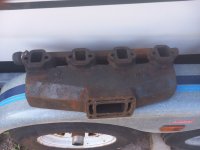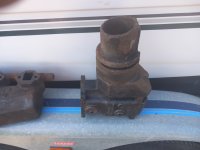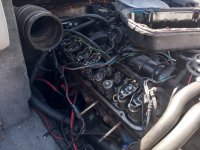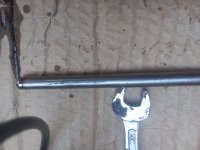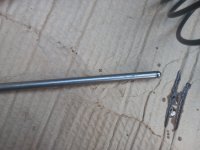Today I took the road cover back off the boat with intention of doing a compression test, I'd already removed the plugs and had also removed the
air filter flame arrestor (just for a better view of the rear of the transom and components mounted on it).
We had a rain storm the other day and it seems the road cover had a bit of a leak.. I was working in the yard the other day and could hear the little bilge pump had turned on (makes sense that it will be connected directly to a battery, I had turned the battery isolator off). The pump was running but there was no water pumping out of the side of the boat so I expect the outlet pipe from the bilge pump is disconnected. I removed the bilge plug, around 10 gallons of water came out and the bilge pump turned itself off. The little bilge pump not pumping water out of the boat is the least of my concerns at the moment...!
Connected a battery charger so the battery(s) would be fully charged for the compression test (the bilge pump running for hours would have taken some charge) and turned the key to crank the engine... Loads of water spat out of the starboard side plug holes :-( . Now it could be that some rain water got into the carb through the road cover... The boat is leaning slightly to starboard in my yard so if water got into the inlet I might expect it to slosh in the inlet manifold to the starboard cylinder bank. But I think it's more likely that there's a problem with the starboard exhaust manifold, it looks like someone had tried to bodge it with some type of sealant on it's outside before, have to wonder if it's also cracked internally, probably due to freeze damage... And water getting into cylinders causing hydraulic lock would explain the 'pause' I previously mentioned during cranking when I repeatedly turned the engine off and restarted it (to remove plug leads in turn to check to test to see if the knock went away) when I had it on the water.
In these pics it looks like someone has applied a thin layer of some type of sealant to a crack (the bottom rusty line running the length of the manifold).
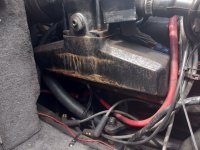
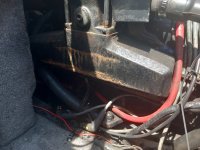
I can buy another 'BARR' brand (the supplier says a premium US made brand?) manifold from a UK supplier for £312 + a bit for shipping. But that's just the manifold not including the riser. Is there potential for a problem in the riser too? Or I could buy a complete new set of BARR manifolds and risers for £1080 from the same supplier. Both deals are on this web page
https://repowermarine.com/buy-omc-e...arts/omc-exhaust-system/manifolds-risers.html . I haven't checked to see how those prices compare to US supplier prices but I'd expect them to be more expensive this side of the Atlantic...
Anyone got any thoughts? Should I buy just the manifold or is there potential for a problem in the riser? Or would you buy the whole set in case there's a similar problem at the port side?
There's no water in the oil and the oil hasn't gone down, so I assume the block and heads are not cracked... Is that a safe assumption?
I might also assume that the knock is from either a bent pushrod / damaged follower or bent conrod / damaged big end bearing / damaged piston rings caused by hydraulic lock... Thoughts?
Obviously fixing a cooling system problem / water entering cylinders problem won't cure any damage caused to the engine by previous hydraulic lock (or rust due to water in cylinders left standing) but I've got both problems (cooling and knock) to fix anyway and if I buy the cooling system components I'll still have them when I've fixed the knock, just have to buy new gaskets if I remove and refit new cooling system components to fix the knock.
I might pull the inlet manifold to see if I can see any problem with cam followers... Assuming the inlet manifold on the carb engine is heated, is the gasket (valley gasket?) a special marine part or is it just the same as a standard inlet manifold gasket?
Simon






















